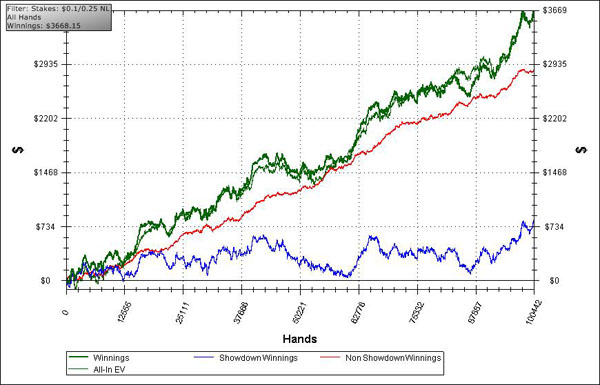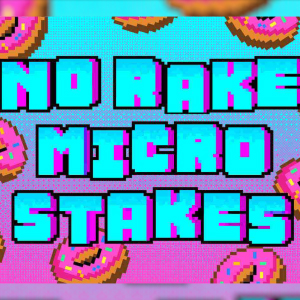Contents:
- What is the Red-Line in poker?
- Is Red-Line really important?
-Should I have a positive Red-Line?
- Why are high Red-Lines popular?
- Which factors influence the Red-Line
What is the Red-Line?
A popular trend in
online poker is to have a graph where the red-line is either
break-even or positive. The red line represents money won without
seeing a showdown; i.e money won when our opponent folds at some
point postflop. The blue line in our graph represents money won when
seeing a showdown, while the green-line represents overall winnings
(the red-line + the blue-line).

Is the Red-Line Important?
The answer
is, it can be, but not always. Our primary concern should be
having a green line that is positive. It is not necessarily a big
deal that our red line is negative so long as we are having a decent
winrate overall. In other words, there is no inherent benefit to
having a positive red-line.
For example, calling stations will typically have a positive red
line. Their red line will not decrease because they rarely fold.
However since they go to showdown so wide in most cases their blue
line will be so bad that their overall winnings are negative.
The
red-line is only important if it is good for the correct reasons.
It's not difficult to arbitrarily increase red-line by just never
folding postflop, but this clearly would be a poor strategy. The
majority of players with break-even or positive red-lines are
actually losing players. It can be necessary for them to adjust their
style to one with a falling red-line and only then begin to increase
their red-line, but this time in the correct way.
Should I have a Positive Red-Line?
It is recommended for newer players at the lower limits to
focus particular attention on their blue-line and let their red-line
fall. A rough guide is that so long as the red-line is losing at less
than about 10bb/100 hands for 6max players playing 100bb effective
stacks there is unlikely to be a problem. For such a red-line, the
corresponding blue-line should be around 14bb/100 or higher which
will result in a positive winrate.
There are two reasons for
this. Firstly it's simply an easier way to play the game when first
starting out. We can focus on making hands and extracting value and
then focus on the bluffing aspects of the game at a later point when
we have become proficient atvalue-betting. The second reason is that
in certain lower limit games we may find ourselves playing against
opponents who don't fold much, making it especially complex to play a
positive red-line strategy.
Does this mean a positive red-line
strategy at the micro-limits is impossible? Not at all – the
displayed graph is played at micro-stakes and correct strategies have
been used to boost red-line earnings.
The higher up in limits
we play the more likely we should be to have a break-even or positive
red-line. Certain types of strategy are also associated with positive
red-line. For example it is very common for players following a
short-stack strategy to have rising red-lines and falling blue-lines.
Why is a positive Red-Line so popular?
So if it's not necessary for players at the
lower limits to have a positive red-line, why do many low-limit
players attach so much importance to it? There are two possible
reasons for this.
1. It's common for high stakes regulars to have a positive/break-even red line, so players at the lower-limits want to imitate this
2. Ego. It's simply considered cool to have a positive red-line
even if the reasons are not based on an accurate understanding of the
game.
Which Factors Influence Red-Line?
There are three main generalisations we can make regarding someone with a low red line. We will consider how to improve our red-line in part 2 of this series.
1. Folding the best hand too frequently. A quick example
might be opening preflop quite wide and then folding 85% of the time
to 3bets.
2. Not getting opponent to fold the best hand
frequently enough. This doesn't necessarily have to be huge
3barrel bluffs (but does include these). For example a river spot
where we have T-high, and let our opponent showdown his J-high and
rake a small pot. It's so easy to take it from him here (even if he
is a calling station) – the small pots can really add up.
3.
Not value betting thinly enough. This may seem
counter-intuitive at first since isn't the blue-line mainly
associated with value-betting? Imagine a river spot where we hold a
thin value-hand in position. Assuming we check back the results of
the hand will always affect the blue-line, never the red line.
Assuming we bet however, the results may affect the blue line
(assuming we get called), but some percentage of the time our
opponent is surely folding, resulting in an increase to our red-line.
Players with a tendency to strongly over-value made hands often end
up with a break-even or positive red line.
In part 2 we
will discuss common spots to increase red-line in the correct way.


